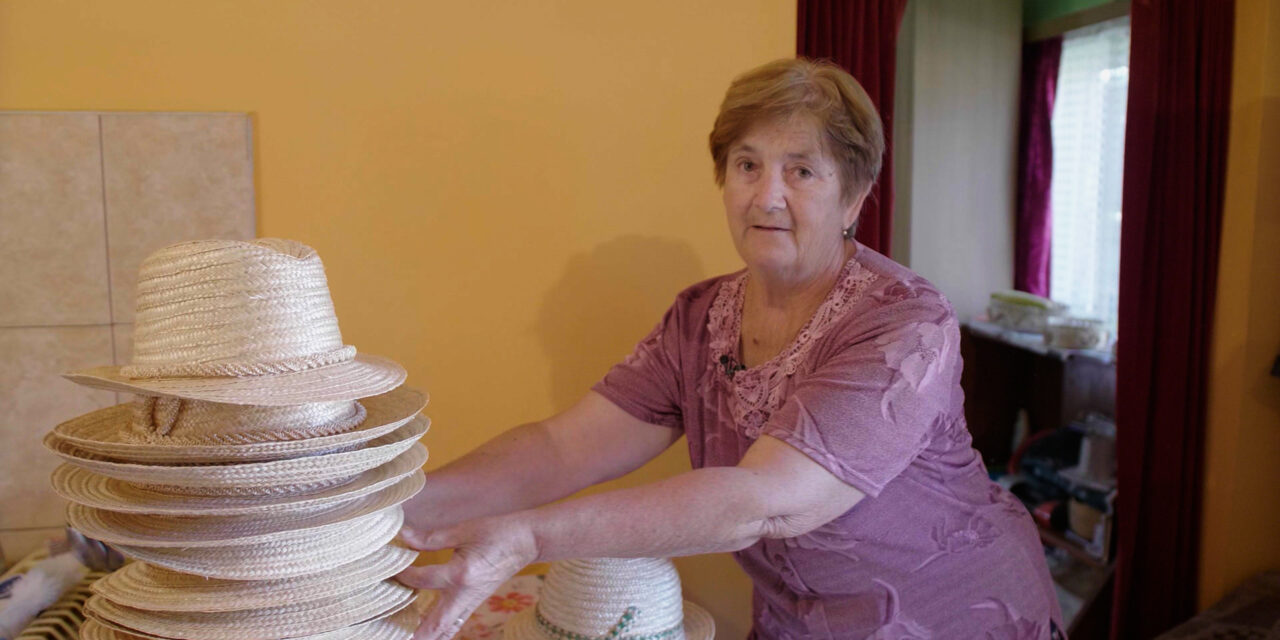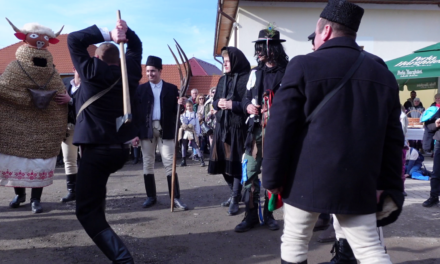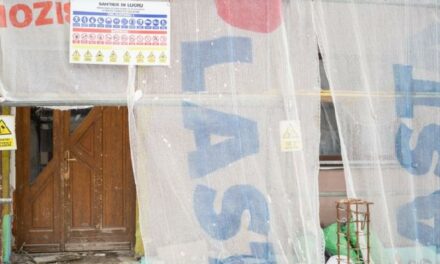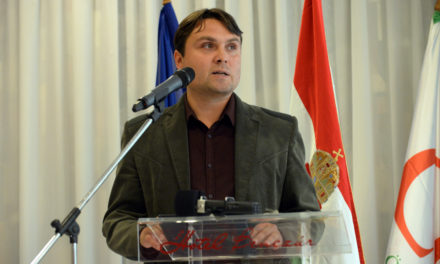Until 1958, everyone sewed straw hats independently on Jobbágytelke, in winter, when there was no work in the fields, they knitted the hats as one person, from the beginning of November until Holy Week before Easter.
Jobbágytelke is one of the most unique settlements in the Felső-Nýárádmente, surrounded by hills, inhabited by hard-working people, men and women with dancing feet. The village of Székely is known to almost every Transylvanian person: this is the settlement that, during communism, was famous for its opposition to collectivization; and while no one was watching, in two weeks, despite being forbidden, he built a Catholic church with his own hands. To this day, it is famous for the strength of its community: this part of the Szentföld, as it is called in Maros County, even though it has suffered from the emigration of young people, is still inhabited by faithful, hardworking people who trust in their traditions. village artisans knit straw hats, and he also dedicates his life to agriculture.
During our visit to Jobbágytelk, Veronka Orbán, an enthusiastic member of the village community, guided us around the settlement, while local craftswoman Regina Bakó showed us the art of knitting straw hats. The settlement is special in several ways, on the one hand, because it is part of the Holy Land, which can be explained by the fact that during the Reformation, along with the settlements of Szováta, Nyárádremete, Nyárádköszvénies, Mikháza, Deményháza, Ehed and Székelyhodos, it retained its Catholic faith thanks to the intercession of two Franciscan monks.
The village lives mostly from agriculture, their centuries-old "industry" is the making of straw hats, with which they supplied men, women and children from Beszterce to Cluj-Napoca as early as the 1700s. According to Veronka Orbán, in the spring, when the weather warms up, the industrious people of Jobbágytelk overflow the border, and even today they do not dare to do manual labor in the fields if they do not have a machine at their disposal.
It is particularly admirable that, despite the fact that the village is bordered by Romanian-speaking and cultural settlements on both sides - Alsó- and Felső-Köhér in the north, and Oláh-Telek in the west - it has remained Székely for centuries. Today, however, there are only 313 families, approximately 713 inhabitants, although there was a time when several thousand lived in the settlement - detailed our hosts, who spoke so enthusiastically about their native village, as if they were raving about their heritage and the multitude of treasures.
We learned that, until the middle of the twentieth century, the parents did not allow their sons to court in the neighboring villages and insisted that they marry a serf's daughter, the lands remained in the immediate family. Today, however, the depopulation of Jobbágytelke can be felt, if the visitor looks around, he sees abandoned houses in almost every alley. The sad reality is also felt by the locals who, since the regime change, are faced with the fact that the number of deaths exceeds the number of births every year at the New Year's Masses since the change of regime, because the youth move to the city or abroad in the hope of a better life, and most of them do not return anymore, only visiting as they get older to his parents.
The dancing and singing village, which also made Béla Bartók's heart beat
When Aunty Veronka introduces the richly furnished village museum, she proudly admits that every piece of it was donated by the locals for the benefit of the community, so dozens of Székely clothes, children's, girls', women's, old women's, men's, young men's and old men's clothes are displayed to the visitor. Well, not in the usual black and red color that defines national costumes these days! Pink, green, mustard yellow, brown, blue and various combinations of these are typical of the costumes.
The folk heritage of Jobbágytelke is more varied than that of many settlements in Transylvania: it is a jewel box of folk costumes, folk music and folk dance, and it became famous even in the last century, which is why it attracted Béla Bartók to the settlement. He collected 41 folk songs there, including the well-known one beginning with Erdő, erdő, erdő, Maros Széki kerek erdő. Aunt Veronka's family still remembers the visit. A then eleven-year-old girl experienced it and later told her children and grandchildren with great joy that
"Uncle Béla's favorite was chicken paprikash with sour cream, but when he got home in the evening from a trip to the village, he was also happy to have curd pudding".
Jobbágytelk Folk Ensemble and dance camp
The village's dance group was founded by Antal Balla, everyone's Uncle Anti, to whom the settlement owed a lot not only in terms of cultural life, but also in its survival: as he was the council secretary of the Székelyhodos village for 31 years and a council official for 10 years, he was the main driving force involved in avoiding collectivization: under his leadership, the poor they referred to farmland, the hilly land, so they could avoid collectivization. At the same time, he led the folk dance group for sixty-five years and taught folk plays to young people.
Already in 1949, they achieved national first place, in 1953 already the VI. They also finished first at the World Youth Festival, and in 1977, 1979 and 1981 they also came home with first prize from the county stage of We Sing Romania. In addition to these, they received several second places, silver medals and awards, and their reputation brought them to several domestic and foreign guest performances.
We already wrote about what the presence of Antal Balla gave to the villagers in our previous article: they were so attached to their heritage that they remained Székely even abroad, they created a small Jobbágy plot around themselves where they settled, and continued to dance and sing what he used to cheer them up from home.
Although the community is slowly dwindling, Jobbágytelke still flourishes once a year during the dance camps.
"It was just the 25th anniversary of the folk dance camp, it cheers up the village. Even at the beginning, it was different, because then old people also came and danced in the evening. There is no other place where older people go. And they stay there with their grandson. And then the children come home from the city, and then the mothers sit with them for an hour or two. Because there is that good old music, folk music, not these drummers and horn players, but folk music"
Aunt Veronka recalled.
The tradition of hat knitting
They were also informed that the poor, hilly soil produced a good crop of durum wheat, which provided a livelihood for the people of the village, as it made hat knitting an industry. In 1831, the newly arrived parish priest introduced the people of the village to the craft of hat knitting, until 1958 everyone sewed straw hats independently on Jobbágytelke. In winter, when there was no work in the fields, they knitted the hat as one person, from the beginning of November until Holy Week before Easter. They gathered in céks, i.e. spinners, and women and girls worked together on these occasions - Regina Bakó, a local resident, who learned hat knitting from her father, introduced me to the traditions of the settlement.
As he said, during the harvest, the boys and men worked with scythes, the girls and women worked with sickles, then they picked up the cut wheat and tied it into sheaves, which the men put together in bundles. After the harvest, the girls and women picked the straw. The fibers of the wheat suitable for processing were tied into fists and then placed on the barn. The remaining sheaves after straw harvesting were put together in sections, and threshing could begin, which in the past was done with threshers and then with threshing machines: by beating, beating, and beating the ear of wheat, wheat grains and straw suitable for seed were separately selected.
Handfuls of straw went through a long process until they were suitable for knitting hats. First it was cleaned, it was selected separately: thin and thick, and then it was put on the smoke. This is how it became suitable for knitting hat braids and laces.
As they said, the dancing hat of the past was made with a completely different motive and method than the average straw hat. If the girl accepted the young man's courtship intention and approach, around harvest time she made a hand-embroidered handkerchief for her lover, which she wore in the young man's lapel (vest) pocket. After that, he wove straw hats, and it sometimes took three years to gather straw suitable for tying the hat. The length of the hat braid is 52 meters, made of 11 strands of straw. The girl knitted and sewed it with her own hands. He pressed the layers of the braid together with his free hand so tightly when sewing that, due to his tightness, he didn't even let the rain through. In return, the young man thanked the precious harvest gift with a silk scarf on the farewell holiday of Jobbágytelke, the day of the Little Blessed Lady (September 8).
Featured image: Maszol / Szilvia Bereczki













